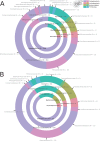Culture-based analysis of Pristionchus-associated microbiota from beetles and figs for studying nematode-bacterial interactions
- PMID: 29864131
- PMCID: PMC5986141
- DOI: 10.1371/journal.pone.0198018
Culture-based analysis of Pristionchus-associated microbiota from beetles and figs for studying nematode-bacterial interactions
Abstract
The interplay with bacteria is of crucial importance for the interaction of multicellular organisms with their environments. Studying the associations between the nematode model organisms Caenorhabditis elegans and Pristionchus pacificus with bacteria constitutes a powerful system to investigate these interactions at a mechanistic level. P. pacificus is found in association with scarab beetles in nature and recent studies revealed the succession and dynamics of this nematode and its microbiome during the decomposition of one particular host species, the rhinoceros beetle Oryctes borbonicus on La Réunion Island. However, these studies were performed using culture-free methods, with no attempt made to establish bacterial cultures from the beetle-nematode ecosystem and to investigate the effects of these microbes on life history traits in P. pacificus. Here, we establish and characterize a collection of 136 bacterial strains that have been isolated from scarab beetles and figs, another Pristionchus-associated environment, as a resource for studying their effect on various nematode traits. Classification based on 16S sequencing identified members of four bacterial phyla with the class of Gammaproteobacteria representing the majority with 81 strains. Assessing the survival of P. pacificus on individual bacteria allowed us to propose candidate groups of pathogens such as Bacillaceae, Actinobacteria, and Serratia. In combination with chemoattraction data, it was revealed that P. pacificus is able to recognize and avoid certain groups of pathogens, but not others. Our collection of bacterial strains forms a natural resource to study the effects of bacterial diet on development and other traits. Furthermore, these results will form the basis of future studies to elucidate the molecular mechanisms of recognition and pathogenicity.
Conflict of interest statement
The authors have declared that no competing interests exist.
Figures





References
-
- Althani AA, Marei HE, Hamdi WS, Nasrallah GK, El Zowalaty ME, Al Khodor S, et al. Human microbiome and its association with health and diseases. J Cell Physiol. 2016. August; 231(8):1688–94. doi: 10.1002/jcp.25284 - DOI - PubMed
-
- Yilmaz LS, Walhout AJM. Worms, bacteria, and micronutrients: an elegant model of our diet. Trends Genet. 2014. November 26;30(11):496–503. doi: 10.1016/j.tig.2014.07.010 - DOI - PMC - PubMed
-
- Watson E, MacNeil LT, Ritter AD, Yilmaz LS, Rosebrock AP, Caudy AA, et al. Interspecies systems biology uncovers metabolites affecting C. elegans gene expression and life history traits. Cell. 2014. February 13;156(4):759–70. doi: 10.1016/j.cell.2014.01.047 - DOI - PMC - PubMed
-
- MacNeil L, Watson E, Arda HE, Zhu LJ, Walhout AJM. Diet-induced developmental acceleration independent of TOR and Insulin in C. elegans. Cell. 2013. March 28;153(1): doi: 10.1016/j.cell.2013.02.049 - DOI - PMC - PubMed
-
- Sommer RJ, Carta LK, Kim S, Sternberg PW. Morphological, genetic and molecular description of Pristionchus pacificus sp. n.(Nematoda: Neodiplogasteridae) Fundam. Appl. Nematol., 1996, 19(6),511–521.
Publication types
MeSH terms
LinkOut - more resources
Full Text Sources
Other Literature Sources

